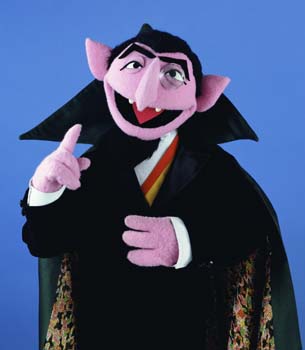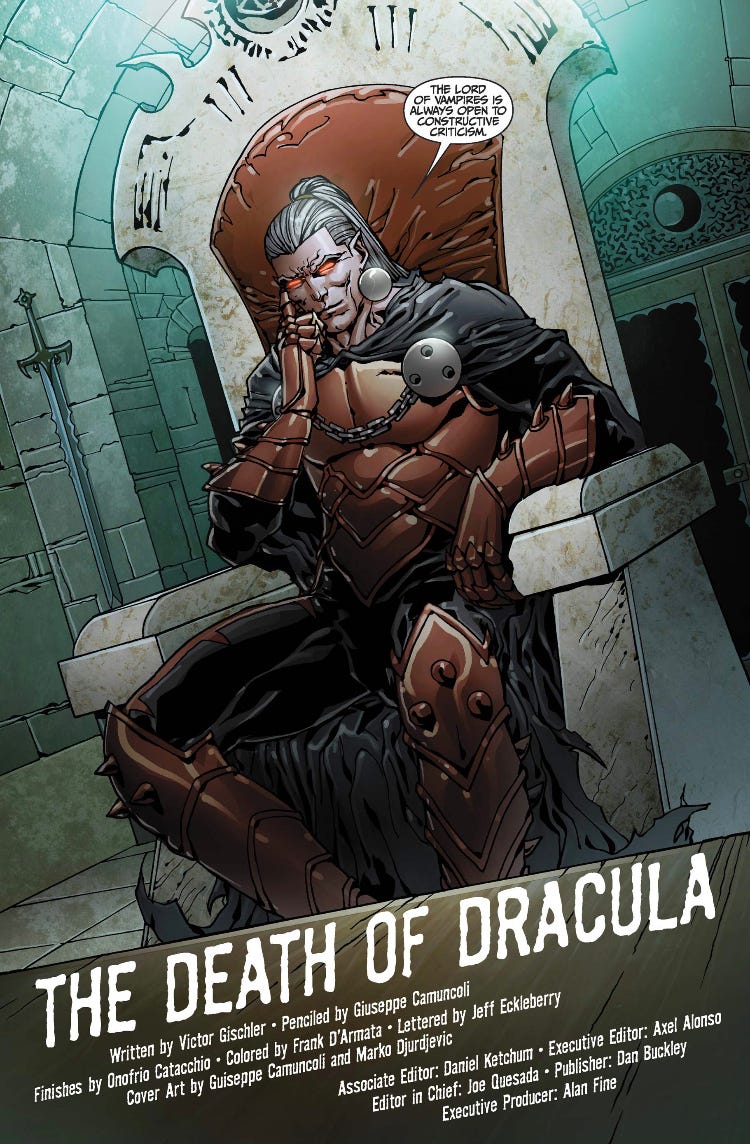I’m pretty sure the definitive Dracula is represented by Count von Count. I understand he loves to count things!
I have a theory, which I just came up with: all modern vampires are David Bowie. Bowie, after all, was the very model of a modern major vampire: impossibly handsome, inhumanly graceful, seductive, dangerous. Almost, but not quite, completely human.
But it’s not just that: each of Bowie’s “personas” is a different modern vampire archetype:
Ziggy Stardust: sexually ambiguous vampire.
Aladdin Sane: glam-punk vampire.
The Thin White Duke: rich jerk vampire.
The Goblin King: aristocratic enchanter vampire.
The Blind Prophet: elder vampire god.
In other words, all vampires are actually David Bowie.
and Bowie did play the vampire’s consort in The Hunger
But nobody ever said, “Bowie sucks!”
One other aspect is mutability - transforming as they either get a massive pick-me-up or actual rejuvenation and age-reversal from the blood of people, especially young wirgins. Played to good effect in a lot of movies featuring vampires as elegant aristos. My modern reference for this would be Claes Bang in the Mark Gatiss / Steve Moffatt Dracula, and he has heaps of fun with it.
And a good example of vampires as being just like regular folks would have to be those in Near Dark.
Except for Mick Jagger.
Vampires go for the jugular, right? Has there ever been a vampire that had trouble lining up the jugular with his fangs? Apparently both fangs have to make holes. Are jugulars puncture resistant at all? Would holes in the jugular seal back up after blood extraction? So many important questions.
Vampire saliva has wound-healing properties
Marvel Comics frequently used Dracula as a villain, and he even had his own series in the 70s. They largely held onto the classic Dracula look.
Recently, they updated his look for the Modern Age. I’m not sure when this actually happened or why, but they made him look more like a dark knight and gave him a ponytail.
When Hollywood discovered that sexy, sensuous, and beautiful vampires made their demographic swoon and ask for more, the image of the vampire changed forever. Vampires, by virtue of what they are, are soulless, undead demons. That doesn’t sell nearly as well, though.
Grandpa Munster had white streaks and tufts of hair at his ears, but he didn’t really have Huntley’s “devil horns”. They were so prominent that they showed up in caricatures of the character.
Just another example of the “titled vampire”, like Count Chocula.
Thanks for the reminder …
Where I live there was a sorta-wealthy philanthropist whose donating heyday was the 1970s-1990s. He died a few years before I moved here. As a local fatcat, lots of local civic landmarks have his name on them. He was real fond of putting his name on the stuff he paid for or was a major contributor to.
To all indications he was an ordinary American made good, but he claimed to be descended from minor royalty in some central European country, so in his more successful years he styled himself Count [whatever]. Detractors said he’d paid somebody over there to buy the rights to the title.
Anyhow, whenever I see the monuments or parks or civic whatever’s emblazoned “Count [whatever]” I read them as “Count Chocula” and get a chuckula from my childish wit. ![]()
I’m sure that when they were creating that character, Jim Henson and the gang were just going for the pun of “Count,” the title of nobility, and “count,” the verb meaning “to total up the number of items.”
But it is also true that in many legends, vampires are said to have a compulsion to count things. So much so that you can protect yourself from them by scattering seeds or grains of rice in their path. They will be compelled to pick up and count each individual seed, leaving you plenty of time to get away.
I don’t know if the Muppet folks were aware of that bit of lore, but it makes for some nice verisimilitude.
I started all this, by the way, because I wanted to point out that the stereotyped appearance given to vampires could have gone in a completely different direction. Right now we have “Look like ordinary folks” or “Bela Lugosi Formal” or “Nosferatu weird”. The strength of the vampire isn’t that “no one will believe in him” (whatever Van Helsing may have said), but that he can “pass” for normal. That’s how Lord Ruthven, right at the start of th modern vampire era, seduced and married the narrator’s sister. As Donald Glut put it, the play “Dracula” was basically a drawing-room drama, so Dracula had to look like the person who would be welcomed into a drawing room. Lugosi’s Dracula looked pretty normal, he just dressed fancier and, as an Eastern European aristocrat, was exotic. But he could walk down the street and not stand out. Of the three types, “Nosferati weird” couldn’t do that. The film was made to emphasize his difference, with that bald head and protruding incisors and long fingers, he was like a human rat. He was supposed to be the plague incarnate (a plague reaches the city just as he does, something emphasized in the 1979 remake). But you look at him and you instantly think “vampire”. There’s a TV commercial right now featuring a guy in a theater full of Nosferatu look-alikes, and they don’t have to explicitly point out that they’re vampires.
But vampires could’ve gone in different directions:
1.) Not-quite Rotting Corpse – the traditional vampire was a creature who had ben buried at a crossroads, a suicide or other transgressor. You knew they were a vampire because they lived in small communities, so people knew they were dead. They didn’t speak, sometimes had blood coming from their eyes or mouth, and smelled terrible. If they cleaned themselves up, they could “pass” for normal, but they didn’t do that. As far as I know, no modern movie or stage interpretation gives us the smelly, bad breathed, untidy and bloody mouthed or eyed vampire.
2.) The Raymond Huntley – Well-dressed but with Devil-Horn hair. I;m not surprised nobody does this one – it’s hard to take seriously.
3.) The “London After Midnight” look. he looks kinda weird, but, at least until he opened his mouth and showed you those individually pointed teeth, he, too, could “pass”:
I’m a little surprised that no one else copied the look – it was from a major studio (MGM, rather than Universal). But maybe the demands of the makeup were too much. Nobody exactly copied Lon Chaney’s Phantom of the Opera makeup either, preferring to go off in other directions (at least, not until James Cagney played Chaney in Man of a Thousand Faces. Or until John Zacherle emphasized his own features that resembled those of the Phantom in his TV appearances as “Roland” or "Zacherley)
4.) The “Morticia” female vampire sort of caught on, but, interestingly, not as a vampire. I think Lily Munster was supposed to be a vampire, but nobody said so. Morticia wasn’t obviously one. When they made the Elvira movie the writers and producers had a big discussion about what exactly she was – was she a witch? or a vampire? or something else? The only one that still exhibits the trope is Vampirella, although she kept the long hair and sexiness, but gave up the slinky dark dress in place of lots of skin.
I suspect that’s the main reason. Chaney’s makeups were famously quite painful for him, and a lot of actors would balk at that. He might have exaggerated just how painful it was, for the sake of publicity, but I have no doubt that he was mostly honest about it. Boris Karloff and Lon Chaney, Jr. both commented on how uncomfortable their various monster makeups were. Chaney, Sr.'s makeup went even further than theirs did.
Chaney Sr. was also operating in the days before SAG and other unions, who would have tried to limit just how much physical pain an actor would be required to endure for the sake of the movie.
Her maiden name was Dracula, but otherwise I don’t recall it being referred to.
Mr. Haggerty: Name?
Lily Munster: Mrs. Lily Munster.
Mr. Haggerty: [writing it down] Lily…
Lily Munster: Oh, if you don’t mind, I’d rather use my maiden name.
Mr. Haggerty: Well, that’s entirely up to you, eh, what is your maiden name?
Lily Munster: Dracula.
Mr. Haggerty: Dracula? That’s, an… unusual name.
Lily Munster: Oh, not at all. Why, back in the old country the woods are full of them.
Two interesting vampire sources:
The New Annotated Dracula by Leslie Klinger. It basically treats the book as a real story, and looks at various historical details such as the phases of the moon and such.
Kim Newman’s Anno Dracula series, which gradually bring in all of the types of vampire into one place as well as other weirdness. Very entertaining.
Klinger’s book is the NEW Annotated Dracula because it replaces the original Annotated Dracula, with notes by Leonard Wolf. Klinger followed Wolf in “treating the book like a real story”, and using a calendar like Wolf did., but he corrects Wolf’s mistakes, and takes advantage of more recent scholarship. Wolf, in the meantime, who had also produced The Annotated Frankenstein, broke ranks with the people producing the “Annotated” series, republishing his work as The Essential Dracula and The Essential Frankenstein (and added to it The Essential Dr. Jeckyll and Mister Hyde and The Essential Phantom of the Opera) Klinger went off and came up with The New Annotated Frankenstein (He also re-annotated books already annotated by others, including The New Annotated Sherlock Holmes (originally annotated by William S. Baring-Gould) and the works of H. P. Lovecraft (which had been annotated for another company by S.T. Joshi)
There are other annotated editions of Dracula in my collection. The annotations are different, and reflect what is interesting or important to the annotator.




